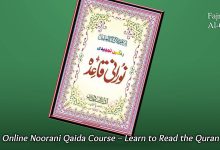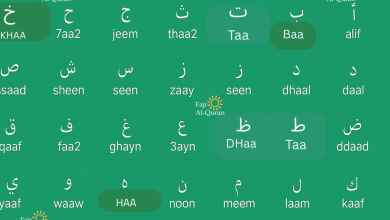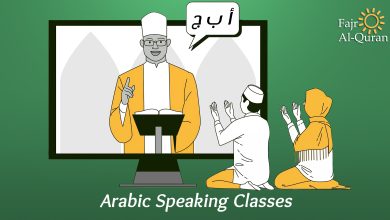Arabic Alphabet for Kids: Fun and Easy Way to Learn Arabic Letters

The Arabic alphabet for kids consists of 28 letters, written from right to left, with most having different forms depending on their position in a word.
To teach the Arabic alphabet to kids, methods like flashcards, worksheets, and songs are used.
Emphasizing that some letters are similar to English ones, while others have unique sounds like “ء” (hamza) or “ح” (ha).
Vowels are represented by small marks called diacritics, which are typically included in children’s books for clarity.
Learning the Arabic alphabet for kids is an exciting journey that opens doors to understanding one of the world’s most beautiful languages.
At Fajr Al-Quran Academy, a leading platform for Quran and Arabic studies, kids can learn the alphabet in Arabic.
It’s through interactive games, printable worksheets, and engaging video lessons designed specifically for young learners.
In this guide, we’ll explore how children can master Arabic letters easily using fun, structured, and creative methods.
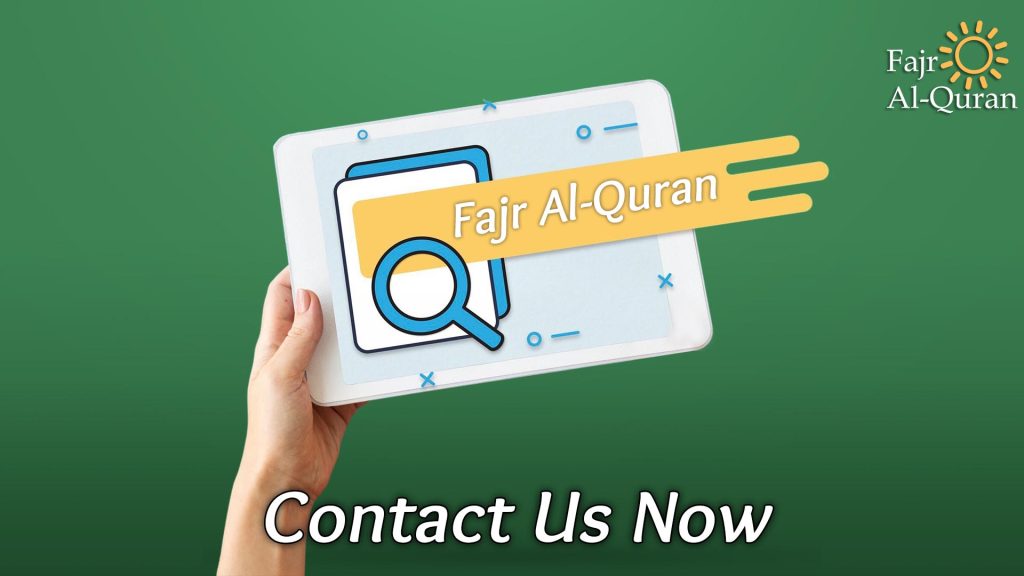
Ready to help your kids learn the Arabic alphabet in a fun way?
Join Fajr Al-Quran Academy and access interactive lessons, printable worksheets, and engaging Arabic games for kids.
Enroll your child today and start learning Arabic letters with joy.
What Is the Arabic Alphabet for Kids?
The Arabic alphabet for kids, also known as Al-abjadiyah, consists of 28 letters primarily representing consonants.
The Arabic alphabet for kids used to write the Arabic language.
Many resources, like cartoons, are available to help children learn the alphabet in a fun and engaging way.
Each letter often has different forms depending on its position in a word.
Before Arabic Alphabet for Kids begin to write or pronounce Arabic letters, they must first understand what makes the Arabic alphabet special.
Unlike English, Arabic has its own rhythm, sounds, and writing direction that make it both challenging and exciting for young learners.
Overview of the Arabic Writing System
The Arabic alphabet for kids consists of 28 letters, each with its unique shape and sound.
Unlike English, Arabic is written from right to left, which is often one of the first fun discoveries for kids learning the Arabic language.
How Many Letters Are in the Arabic Alphabet?
There are 28 primary Arabic letters, and most change their shape depending on whether they appear at the beginning, middle, or end of a word.
This dynamic structure makes learning Arabic both engaging and visually stimulating for children.
Right-to-Left Writing: A Fun New Experience for Kids.
Teaching your child to write from right to left can be a playful challenge to the Arabic Alphabet for kids.
Many Arabic Alphabet worksheets for kids and practice activities offered by Fajr Al-Quran Academy help introduce this concept gradually.
Allowing children to adapt through fun tracing and writing exercises to learn the Arabic Alphabet for kids.

Why Learning the Arabic Alphabet for Kids Is Important
Learning the Arabic alphabet for kids is important as it serves as a foundation for reading, strengthens cultural and religious identity, and enhances cognitive skills like memory and creativity.
The Arabic alphabet for kids allows for a deeper connection to Arabic heritage, culture, and religion, particularly the ability to read the Quran.
While also boosting overall language development and potentially making it easier to learn other languages.
The Role of Arabic in the Quran and Islamic Culture
Arabic is the language of the Holy Quran, and learning its letters helps children connect spiritually while improving their understanding of recitation.
Learning Arabic connects children to the language of the Quran, enriching their understanding of Islamic teachings.
Fajr Al-Quran Academy ensures that students not only learn the alphabet but also appreciate its spiritual significance.
Learn with Fajr Al-Quran Academy Arabic Alphabet in English
Benefits of Early Language Learning for Kids
Learning Arabic enhances focus, creativity, and communication abilities.
Children who learn multiple languages early on develop stronger cognitive, memory, and problem-solving skills.
Introducing them to Arabic letters at a young age boosts confidence and enhances linguistic flexibility.
Building a Strong Foundation for Future Arabic Studies.
Mastering Arabic letters prepares children for reading short words, learning Quranic verses, and eventually achieving fluency in Arabic writing and speaking.
Mastering the Arabic alphabet is the first step toward reading and writing fluently.
Once kids are comfortable recognizing and pronouncing letters, they can progress to forming simple words and understanding Arabic sounds.
Fun and Interactive Methods to Teach the Arabic Alphabet for Kids.
Learn the Arabic Alphabet best when they’re having fun.
Using games, songs, and interactive lessons, parents and teachers can turn Arabic learning into an adventure instead of a chore.
Using Games and Flashcards to Reinforce Learning
The Arabic Alphabet for kids games and flashcards help kids recognize letters faster.
Fajr Al-Quran Academy uses colorful visuals and memory games to keep lessons exciting.
Interactive games make the Arabic Alphabet for kids easy for kids to memorize Arabic letters.
Also, uses colorful flashcards, letter-matching activities, and Arabic memory games to make learning the Arabic Alphabet exciting and effective.
Storytelling and Songs for Memorization
Songs are a powerful way to teach the Arabic alphabet for kids. Through rhythm and repetition, kids easily remember letter sounds and sequences.
Music and stories help children remember new information faster.
Introducing the Arabic alphabet for kids’ songs allows them to connect letters with rhythm and melody, making learning naturally enjoyable.
Digital Learning Apps and Online Arabic Platforms for Kids.
Online resources such as Fajr Al-Quran Academy combine digital tools, videos, and interactive worksheets to help kids learn the Arabic alphabet for kids at their own pace.
Online platforms like Fajr Al-Quran Academy combine structured lessons with engaging video content and interactive worksheets that motivate children to practice consistently from home.
Step-by-Step Guide to Learning Arabic Letters for Kids
Learning the Arabic alphabet for Kids becomes easier with a clear, step-by-step plan.
Each stage, from recognition to writing and pronunciation, builds on the last to ensure children grasp each letter confidently.
Start with Recognizing and Pronouncing Each Letter
Children should begin by listening carefully to the sounds of each Arabic letter and associating them with shapes.
Teachers at Fajr Al-Quran Academy support this step with visuals, sound clips, and repetition.
Also, interactive lessons to help kids recognize letters confidently.
Each Arabic letter has its unique sound, and learning correct pronunciation early is crucial.
Practice Writing Arabic Letters the Right Way.
Writing Arabic letters correctly is vital.
Printable worksheets guide children to trace and write letters neatly, improving both understanding and hand coordination.
Parents can download worksheets for daily practice sessions at home.
Writing in Arabic involves curves and dots that differentiate one letter from another.
Combine Letters to Form Simple Arabic Words
After recognizing individual letters, kids can start connecting them to form simple Arabic words, an essential step toward reading fluently.
This gradual approach, starting from isolated letters to connected words, builds confidence and reinforces memory retention.
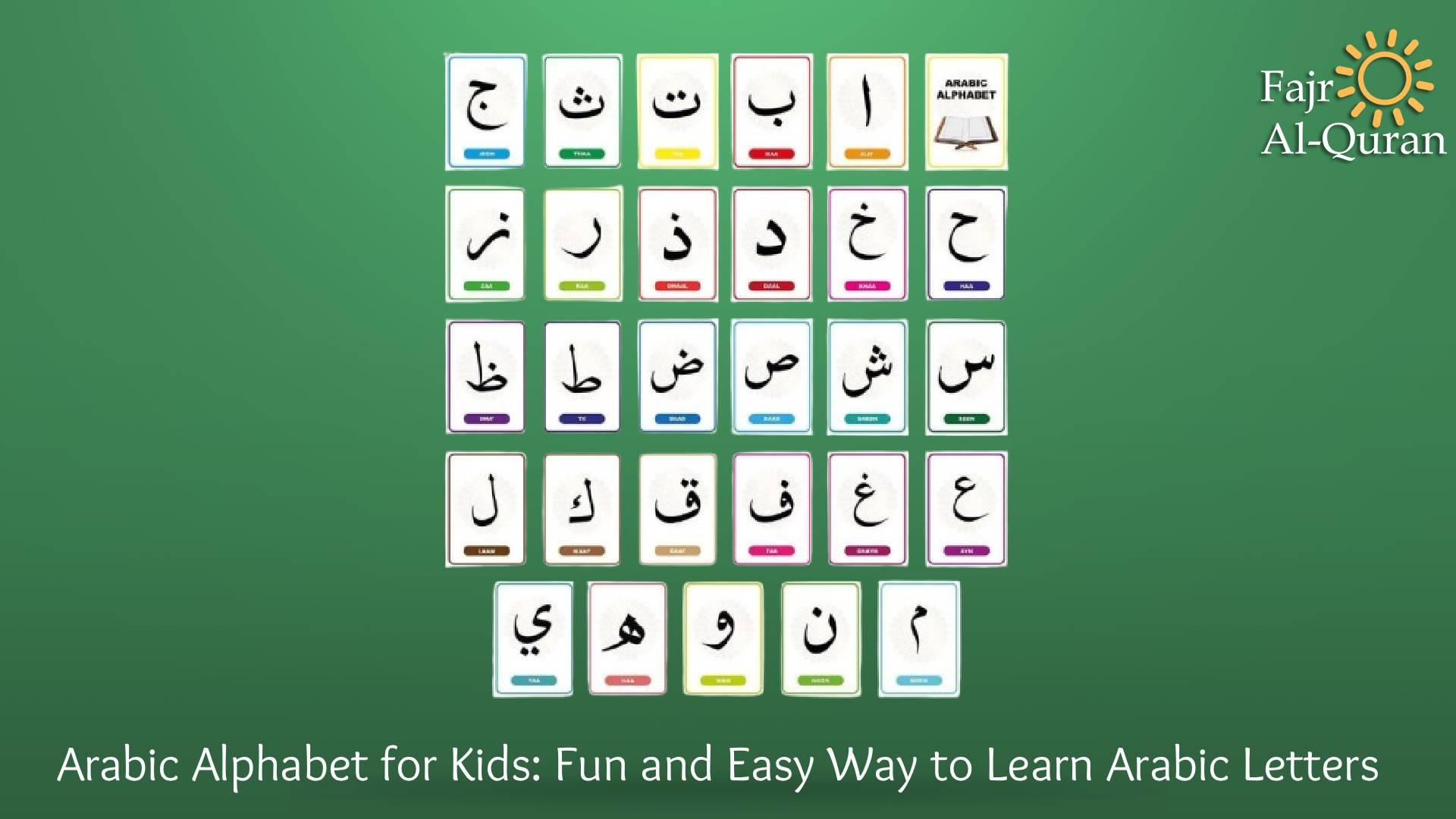
Colorful Arabic Alphabet Charts and Flashcards for Kids
Children are visual learners.
Arabic alphabet for kids charts and flashcards make learning visually appealing and interactive, turning letter recognition into a daily activity.
Benefits of Visual Learning for Young Minds
Visuals play a big role in early learning.
Colorful charts and flashcards help children associate Arabic letters with images, words, and sounds, turning learning into an immersive experience.
Colorful visuals help children connect letters with images, which enhances memory and learning speed.
How to Use the Arabic Alphabet for Kids Charts Effectively
Place Arabic Alphabet for Kids charts in study areas or playrooms where kids can see them daily.
Repetition and visibility are key to long-term retention.
DIY Flashcard Ideas for Parents and Teachers
Parents can make simple flashcards at home using colored paper and markers.
Combine letters with matching pictures (like ا for أسد— lion) to make the activity more engaging and interactive.
These DIY tools make lessons more personal and engaging.
Engaging Arabic Alphabet for kids
Combining music, movement, and visuals turns learning the Arabic alphabet for kids into an enjoyable routine.
Children remember better when the learning experience feels like playtime.
The Power of Music in Language Learning
Repetition through melody strengthens pronunciation and recall.
Children naturally respond to rhythm and melody.
Arabic alphabet songs for kids help them remember letter order and sounds faster.
Top Arabic Alphabet Songs for Kids
Platforms like Fajr Al-Quran Academy and various YouTube channels offer lively, child-friendly Arabic alphabet videos that teach letters through catchy tunes and animations.
Tips for Parents to Help Kids Learn Arabic Letters Easily
Parents play a crucial role in helping succeed in learning the Arabic alphabet.
With consistent support and encouragement, every child can master the Arabic alphabet with confidence.
Create a Consistent Learning Schedule at Home
Consistency is key. Dedicate short daily sessions to Arabic alphabet for kids practice to build a solid learning habit.
Set aside 10–15 minutes daily for Arabic practice.
Short, consistent sessions help to learn the Arabic alphabet for kids faster without feeling overwhelmed.
Encourage Practice Through Positive Reinforcement.
Praise motivates children. Celebrate each success, like identifying or writing a new letter, to boost confidence.
Celebrate small achievements. Every time your child identifies or writes a new letter, give praise or a reward to boost motivation.
Turn Everyday Activities into Arabic Learning Opportunities.
Label objects in Arabic or play “find the letter” games during daily activiti1e0s to make Arabic learning fun and natural.
These small actions make learning Arabic a natural part of daily life.
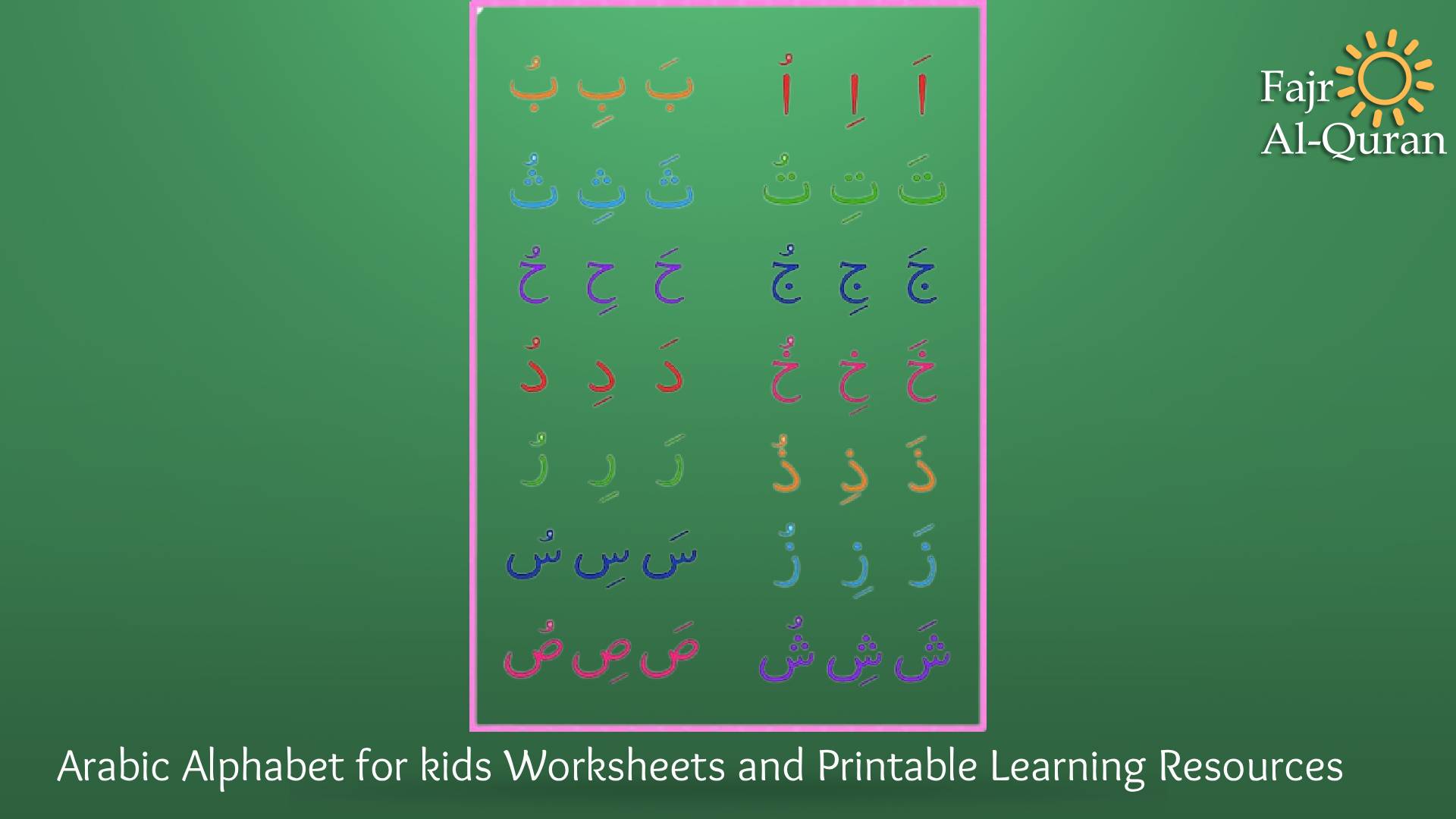
Arabic Alphabet for kids Worksheets and Printable Learning Resources.
Using the Arabic Alphabet Worksheets helps practice what they learn.
From tracing to coloring, these printable resources reinforce recognition, writing, and pronunciation skills to learn the Arabic Alphabet for kids.
Tracing Worksheets to Improve Writing Skills
Tracing sheets help kids understand the flow of Arabic letters, improving handwriting and memorization.
Fajr Al-Quran Academy provides printable and downloadable sheets designed for kids of all levels.
Coloring Activities for Letter Recognition
Coloring pages add fun to learning Arabic.
Kids associate each letter with a color, shape, or word, enhancing recall.
Many worksheets include fun illustrations that connect each letter to familiar objects or animals.
Free and Paid Online Resources for Parents and Teachers
Parents can access free PDFs or invest in structured alphabet for kids learning programs from Fajr Al-Quran Academy.
These combine games, printables, and interactive practice materials for optimal results.
Common Challenges Face While Learning the Arabic alphabet for kids (and How to Fix Them)
Learning Arabic can seem tricky at first.
Some letters look similar or have unfamiliar sounds, but with the right support and tools, these challenges are easy to overcome.
Confusing Similar-Shaped Arabic Letters
Some Arabic letters look alike but differ in dot placement (like ب, ت, and ث).
Using visual aids and comparison charts can help kids recognize these distinctions.
Also, visual worksheets and games help children identify them easily.
Difficulty in Pronouncing Arabic Sounds
Arabic includes sounds unfamiliar to English speakers.
Interactive pronunciation practice and video lessons at Fajr Al-Quran Academy make mastering these sounds simpler.
So, Arabic has unique sounds not found in English.
Fajr Al-Quran Academy instructors use interactive pronunciation games and repetition drills to make learning these sounds easier.
Keeping Learning Fun and Motivating for Kids
Mix games, songs, and worksheets to prevent boredom and sustain enthusiasm.
So, Variety keeps children engaged.
Children learn best when they enjoy the process.
Conclusion
Learning the Arabic alphabet for kids can be a joyful, creative, and rewarding experience.
With the right mix of interactive learning, fun games, printable worksheets, and consistent practice, children can easily master the Arabic letters while developing a love for the language.
At Fajr Al-Quran Academy, the leading platform for Quran and Arabic studies, every child’s learning journey is supported with expert tutors, structured lessons, and engaging materials.
To ensure that learning the alphabet in Arabic is always fun, inspiring, and effective.
………….FAQ…………….
How can children start learning the Arabic alphabet easily?
Kids can start by learning one or two Arabic letters per day using flashcards, songs, and interactive games. Platforms like Fajr Al-Quran Academy offer structured lessons with visuals, videos, and printable worksheets that make the process fun and effective.
How many letters are there in the Arabic alphabet?
The Arabic alphabet consists of 28 letters. Each letter has a unique sound and changes shape depending on its position in the word: beginning, middle, or end.
What are the best ways to teach the Arabic alphabet to kids?
The best methods include using colorful charts, interactive worksheets, videos, and alphabet games. Fajr Al-Quran Academy combines these tools in its online Arabic learning programs to make learning enjoyable for children.
At what age can children start learning Arabic letters?
Children as young as three to five years old can begin recognizing Arabic letters through songs, stories, and visuals. Early exposure helps build strong language skills over time.
Are there printable Arabic alphabet worksheets available for download?
Yes! You can download printable Arabic alphabet worksheets from Fajr Al-Quran Academy and other educational websites. These alphabet worksheets are ideal for practicing writing and recognizing letters at home.
How can I make learning Arabic letters fun for my child?
Incorporate fun activities like coloring letters, watching Arabic alphabet videos, singing songs, and using interactive games. Mixing play with study keeps kids motivated and excited to learn.
What are some common challenges kids face while learning Arabic?
Some kids struggle with similar-shaped letters, correct pronunciation, and writing from right to left. Regular practice, patient teaching, and visual aids help overcome these challenges.
Why should I choose Fajr Al-Quran Academy for my child’s Arabic learning?
Fajr Al-Quran Academy is a leading platform for teaching the Arabic alphabet, Quran recitation, and Tajweed. It offers qualified teachers, interactive lessons, downloadable worksheets, and fun activities tailored to help children learn Arabic letters easily and confidently.



